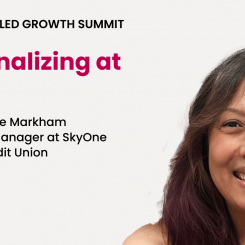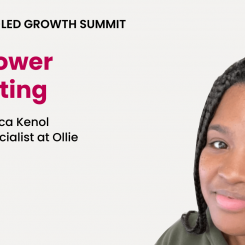Customer-led growth is more than just a marketing strategy; when done right, it becomes the guiding principle behind almost every business decision.
Within a CLG framework, customer feedback seamlessly converts into actionable insights, fostering trust, loyalty, and partnership between you and your customers.
Matt Roche, CEO at Extole, defines CLG as making your existing customers the primary channel to drive awareness, acquisition, and activation. A customer-led growth approach places the customer at the forefront of your business growth and emphasizes the customers’ role as consumers and active contributors to your success.
This holistic integration of customer perspectives enhances brand resilience and lays the foundation for sustained, organic growth in a competitive market landscape; keep reading to discover everything you need to know about customer-led growth in 2024.
What is Customer-Led Growth?
Customer-led growth leverages customer feedback to improve the customer experience and optimize products for customers.
CLG is not a strategy confined to boardrooms; it turns insights into action, which means co-creating with customers. CLG enhances the symbiotic relationship between businesses and customers because customers’ insights help companies develop products that customers want.
Loyalty, in a CLG framework, is an earned currency, and as satisfaction soars, so will your brand’s authenticity.
How Do You Measure Customer-Led Growth?
Determining the most important KPIs for customer-led growth can depend on specific business goals and industry nuances. However, here are five widely recognized KPIs for measuring success in a customer-led growth strategy:
| KPI | What It Measures | Why it’s Important |
| Customer Retention Rate (CRR) | The rate of customers retained over a specific period. | High retention rates indicate customer satisfaction and loyalty, demonstrating the success of CLG efforts in keeping customers engaged. |
| Net Promoter Score (NPS) | Measures the likelihood of customers recommending your brand to others. | NPS is a direct indicator of customer advocacy and satisfaction, which is crucial for understanding the impact of CLG on brand perception. |
| Customer Lifetime Value (LTV) | Predicts the revenue a customer will generate over their entire relationship with the company. | LTV assesses the long-term impact of CLG, focusing on the value customers bring over their entire engagement with the business. |
| Referral Rates | Tracks the percentage of customers who refer others to the business. | Referral rates directly tie into the advocacy aspect of CLG, indicating how effectively satisfied customers are promoting the brand. |
| Community Engagement Metrics | Measures a customer community’s active members, posts, comments, etc.. | Community engagement metrics reflect the success of CLG in building a strong, interactive customer community, contributing to brand loyalty and advocacy. |
While these are not all the KPIs that could be used in a CLG strategy, collectively, these KPIs provide insights into customer satisfaction, loyalty, advocacy, and the overall impact of customer-led strategies on business growth.
It’s essential to tailor KPIs to specific business objectives and the nature of customer interactions within a particular industry.
Why is CLG Important?
Today, more than 75% of B2B buyers consult three or more sources of advocacy before they make a purchase decision, underscoring the importance of establishing a robust network of satisfied customers who can serve as authentic advocates for your brand.
Additionally, acquiring a new customer can cost 5-25 times more than retaining an existing customer. Conversely, CLG increases revenue through customer retention, expansion, advocacy, and community engagement.
Embracing CLG is not just a strategic choice — it is a necessary one. Satisfied customers’ voices hold remarkable influence in shaping purchase decisions and fostering sustained business growth.
Use Case: The Secrets Behind Peloton’s Sustainable Customer-Led Growth
Rapid growth can either be a benefit or cause unstable, chaotic shifts that are hard to maintain; solely focusing on growth is not sufficient to maintain a business in the long run. A devoted following, however, can provide that stability.
When you take the time to build a community, you create a solid foundation that supports the business in between rapid growth periods.
From its start, Peloton has focused on building its community, and that focus is put into its products as well, through community features like the leaderboard and tags. Additionally, that same focus is at the core of Peloton’s approach to social media, instructors-turned-influencers, and user-generated content strategies. Wherever you find Peloton, its followers take center stage no matter the platform.
| You can read more about Peloton’s success with customer-led growth, here. |
Following initial success, Peloton faced significant challenges, including recalls, supply disruptions, and new competitors.
Yet, through it all, Peloton has retained subscribers; in February 2022, Peloton reported a 12-month subscriber retention rate of 92%. Additionally, Peloton’s connected fitness subscribers – those who purchase equipment and pay for the classes – have grown steadily since 2020.
These statistics indicate that Peloton’s customers are devoted to the brand. Peloton’s community-led growth focus provided the solid foundation they needed to support them in between rapid growth periods.
Peloton’s CLG initiatives focus on:
- Community Building: Peloton actively uses social media, private Facebook groups, leaderboards, and gamification to create a devoted community of users, contributing to sustained success during challenging periods.
- Instructor-Led Influencer Marketing: Peloton’s unique approach involves instructors as influential brand ambassadors, becoming influential within and beyond the Peloton community.
- Referral Programs and Advocacy: Peloton’s refer-a-friend program incentivizes brand advocacy and customer acquisition, allowing customers to earn credits for encouraging friends to sign up.
- Social Media Listening and User-Generated Content (UGC): Peloton actively engages in social media listening to understand customer needs, informing updates, and branding efforts. Encouraging user-generated content (UGC) across platforms is a powerful strategy for building brand loyalty through authentic customer stories.
5 Key Considerations for CLG in 2024
Developing a CLG strategy involves understanding your customers’ needs, aligning your offerings with their needs, facilitating a customer-centric culture, and measuring success using metrics like customer engagement and retention rates.
Here are five key considerations to help you get started immediately:
- Prioritize the most effective channels: Identifying and emphasizing channels that yield the highest conversion rates and customer engagement is pivotal for optimizing resource allocation and maximizing business impact.
- Build trust with customers: Establishing trust is foundational; by consistently delivering on promises, providing transparent communication, and ensuring customer satisfaction, a business can cultivate enduring relationships.
- Improve lead generation: Enhancing lead generation processes through targeted marketing strategies, effective use of data, and understanding customer preferences is crucial for sustaining a healthy sales pipeline.
- Update key performance metrics: Regularly reassessing and refining key performance metrics ensures alignment with evolving business objectives and accurately reflects the effectiveness of customer-led growth strategies.
- Focus on value: A strong emphasis on delivering exceptional customer value, whether through innovative products, personalized services, or meaningful experiences, is central to fostering customer satisfaction and loyalty.
Next Steps: Extole For Customer-Led Growth At Scale
Today, customers are driven by social cues, influencers, and referrals from friends and family. With Extole, you can activate customer-led growth and grow customer acquisition with a go-to-market strategy that grows your customer base with less customer acquisition cost (CAC) and higher long-term value (LTV), resulting in a strong LTV:CAC ratio.
Extole pioneered the strategy of putting customers at the center of marketing to deliver higher-quality customers at a lower CAC. Customer-led growth is a highly disciplined go-to-market approach that will transform how you build your customer base.
- Analytics & Reporting: measure, report, optimize
- Personalization: target key segments
- Rewards & Incentives: drive customer loyalty
- Seamless Experiences: app, web, store, and more
- Data & Security: support compliance & data protection
- Internationalization: scale customer engagement
- Integration Flexibility: connect to any system
Your customers are already a customer-led growth channel for you. At Extole, we help you build and manage strong brand advocates who act as a referral network for your company. Sign up for a demo today and learn how we can help you grow sustainably.





